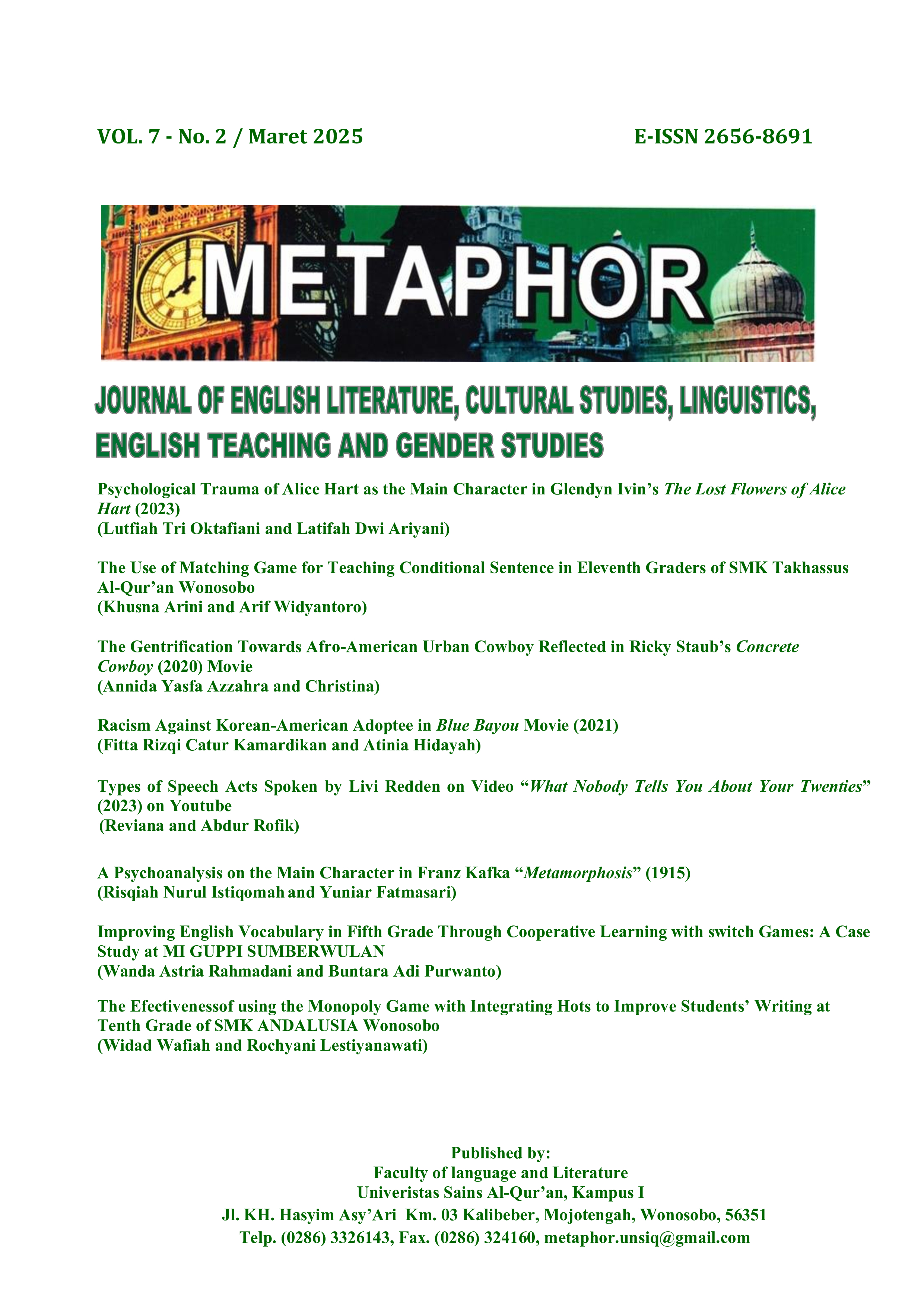The Gentrification Towards Afro-American Urban Cowboy Reflected in Ricky Staub’s Concrete Cowboy (2020) Movie
Keywords:
Gentrification, Urban, Black Cowboy, Concrete CowboyAbstract
This study aims to analyze the gentrification that eliminates the urban cowboy community reflected in Ricky Staub's Concrete Cowboy (2020) and the impacts of gentrification on the urban cowboy community reflected in Ricky Staub's Concrete Cowboy (2020). The study employs a descriptive-qualitative approach to scrutinize Ricky Staub's Concrete Cowboy (2020) as its primary research objective. The research method's data analysis includes watching, reading, identifying, classifying, simplifying, and selecting. The research method involves displaying, explaining, and interpreting the data. The researcher analyzes the data using Gentrification Studies by Rowland Atkinson. The results of this research have shown that there is a process of elimination of the black urban cowboy community through gentrification with developers entering the Fletcher Street Stables area in Ricky Staub's Concrete Cowboy (2020). The impact of gentrification on urban cowboy communities can also be seen in Ricky Staub's Concrete Cowboy (2020), including four data on displacement and eviction, four data on community conflict and crime, four data on racial segregation, and one data on homelessness.
References
Atkinson, R and Bridge, G. (2005). Gentrification in a Global Context: The New Urban Colonialism. London: Routledge.
Brown, S. (2014). Beyond Gentrification: Strategies for Guiding the Conversation and Redirecting the Outcomes of Community Transition. Joint Centre for Housing Studies of Harvard University, Cambridge.
Charles, Camille Z. (2003). The Dynamics of Racial Residential Segregation. Annual Review of Sociology, 29:167–207. From https://doi.org/10.1146/ annurev.soc.29.010202.100002.
Creswell, J. W., & Creswell, J. D. (2018). Research Design: Qualitative, Quantitative, and Mixed Methods Approaches. Thousand Oaks, CA: Sage Publication, Inc.
Crowder, Kyle., Jeremy Pais., & Scott J. South. (2012). Neighborhood Diversity, Metropolitan Constraints, and Household Migration. American Sociological Review, 77 (3): 325–53. From https://doi.org/10.1177/ 0003122412441791.
Glass, R. (1964). Aspects of Change. In the Center for Urban Studies (Ed.), London: Aspects of Change. essay, MacGibbon & Kee, London. From https://hakka3.files.wordpress.com/2017/11/glass-aspects-of-change.pdf.
Hwang, J. (2015). Gentrification, Race, and Immigration in the Changing American City (Doctoral dissertation). Harvard University, Graduate School of Arts & Sciences. From https://dash.harvard.edu/handle/1/23845428.
Hwang, J., & Ding, L. (2020). Unequal Displacement: Gentrification, Racial Stratification, and Residential Destinations in Philadelphia. American Journal Of Sociology, 126(2), 354-406. From https://doi.org/ 10.1086/711015.
Hwang, J., Roberto, E., & Rugh, J. (2019). Gentrification and the Changing Structure of Segregation: A New Decomposition Approach by Race, Class, and the City-Suburb Divide. Population Association of America: Stanford University, Rice University, Brigham Young University. From http://paa2019.populationassociation.org/abstracts/192942.
Less, L., Slater, T., & Wyly, E. (2008). Gentrification (1st edition). Taylor and Francis Group.
Mullins, R. (2024). The Myth of the American Cowboy. Routledge, 4, 15–24. From DOI: 10.4324/9780429491115-16.
Moore, J. M. (2014). “Them’s Fighting Words”: Violence, Masculinity, and the Texas Cowboy in the Late Nineteenth Century. The Journal of the Gilded Age and Progressive Era, 13(1), 28–55. From http://www.jstor.org/stable/ 43903497.
Smith, N. (1979). Movement by Capital, not People Toward a Theory of Gentrification. Journal of the American Planning Association, 45(4), 538–548. From DOI: 10.4324/9781315128061-16.
Swingewood, A., & Laurenson, D. (1972). The Sociology of Literature. New York: Shocken Books.
Taylor, R. & J. Covington. (1988). Neighborhood Changes in Ecology and Violence. Criminology, 26: 553–91. From https://doi.org/10.1111/j.1745-9125.1988.tb00855.x.
Wellek, R., & Warren, A. (1956). Theory of Literature. New York: Harcourt Brace Jovanich,Inc.



